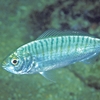General Description
Body very deep, slightly oblong to nearly circular in lateral profile, with thick leathery skin covered in rough denticles, caudal fin absent, replaced by a clavus; clavus with a scalloped margin supported by about 16 rays, with 12 rays bearing closely spaced ossicles, ossicles much broader than spaces between; skin at clavus base uniform, band of reduced denticles absent. Dull brown or greyish above, becoming whitish below. To 3.3 m.
Biology
This species is more common in southern Australia than Mola mola. Its biology is poorly known.
Habitat
Oceanic waters, occasionally entering coastal bays.
Open water
Distribution guide
Southern Hemisphere, including Australian waters.
Species Group
Depth
Water Column
Max Size
3.3 m
Commercial Species
No
Global Dispersal
Recorded in Australia
Conservation Status
- DSE Advisory List : Not listed
- EPBC Act 1999 : Not listed
- IUCN Red List : Not listed





